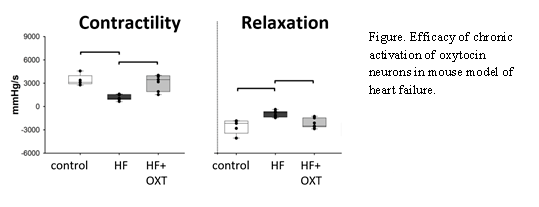Heart failure (HF) results in imbalance of the cardiac autonomic system, i.e. increased sympathetic activity and decreased parasympathetic activity. The present therapies for heart failure only decrease sympathetic activity and have many side effects. There is no drug or device that restores parasympathetic activity.
GW researchers found a new method that increases cardiac parasympathetic activity through chronic activation of neurons stimulated by the oxytocin neuropeptide. Studies on a mouse model of heart failure demonstrated that chronic activation of oxytocin-releasing neurons in the hypothalamus results in improvements in heart structure and function. The hearts of treated mice had reduced left ventricular hypertrophy, as well as increased contractility and relaxation.
GW is already testing intranasal oxytocin in human patients suffering from sleep apnea. This treatment offers a new approach to slow the development of cardiac damage and dysfunction during HF.

Figure: Efficacy of chronic activation of oxytocin neurons in mouse model of heart failure.
Applications:
- Treatment of heart failure
Advantages:
- Improves autonomic balance by effecting both sympathetic and parasympathetic signals
- Prevents hypertrophy of the heart
- Intranasal and self-administrable
- Intranasal oxytocin is already marketed outside U.S. for lactation and inducing labor